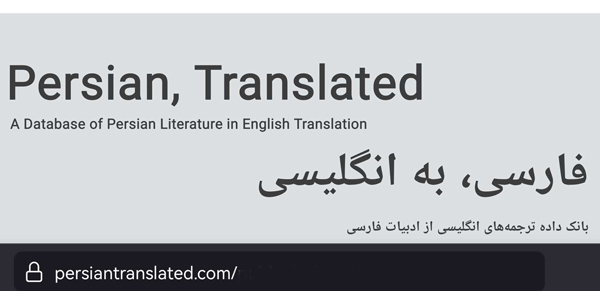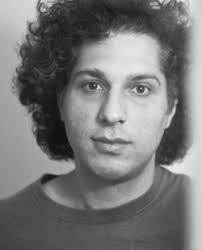

Alireza Taheri Araghi is an Iranian writer and translator. His translations have appeared in Asymptote, Hayden’s Ferry Review, Tripwire, RHINO, and Bat City Review, and his translation of Shahram Shahidi’s Peace Before Cigarette Butt Storm won the 2014 RHINO Translation Prize. His last work, The Immortals of Tehran, a novel in the spirit of Magical Realism, was published by Melville House in 2020. He has recently launched a new project: Persian, Translated, an aspiring database to showcase everything coming from Persian literature in English translation. What follows is a short interview with Araghi about his journey from the streets of Tehran to the idea of a comprehensive database:
PARSAGON: Hi and thanks for this interview with The Persian Literature Review. First of all, tell us a little about yourself. Why did you move to the United States and how did it affect your literary career?
ARAGHI: I was in Iran when I began translating literary fiction in college. It was pure passion. I never dreamed I would make money from it. A couple of years later, I had published three collections of translated short stories and one of my own. Then I moved to the US to study in an MFA program in Creative Writing at the University of Notre Dame. I started without believing that a two-year program would have a big effect on my writing. But I was wrong. The experience helped me change my writing style and habits. I sat in workshops taught by faculty members, themselves published authors and experienced teachers, and not only did I improve my writing techniques, but I learned that to be a writer means to persevere, be strong when rejections come, and I guess, I learned to just love writing. I started publishing short pieces and worked on a novel which came out in the spring of 2020.
PARSAGON: Could you tell us more about this turning point in your writing career? Compared with the style of writing you had practiced back in Iran, what aspects of local writing should a writer-in-English give up in favor of global reception, and what aspects should one maintain or reinforce? How constructive or destructive is the English academia, according to your experience, in determining a ‘foreign’ writer’s orientation?
ARAGHI: In terms of style, I had learned to write a specific type of fiction, basically one that tried to show, not tell. My narrators watched the characters and the world of the story, rarely went into their headspace. I had a strong prejudice against telling the reader what was going on. It took me some time to shed this bias. I wrote the first draft of my novel in the same “cinematic” style. Imagine a camera that reports, that was my narrator. Then I made somewhat of an about face and embraced telling. My omniscient narrator easily reported on what the characters thought and felt. And it opined about history and politics…
PARSAGON: You have published both novels and translations, both in Persian and English. How would you define yourself and which field or medium comes first? Creative writing or translating? Do you consider any significant borderlines between the two?
ARAGHI: I like to think of myself as a fiction writer first and the rest next. I need to point out, though, that I began my literary endeavors as a translator both in Iran and the US. After I translated Richard Brautigan’s Revenge of the Lawn and Samuel Beckett’s Texts for Nothing into Persian, I was mostly known as a literary translator in Iran. Soon after my own collection of short stories came out, I left for the US. My first book-length publication here was also a translation, this time from Persian to English. It was a poetry anthology by seven younger Iranian poets called I Am a Face Sympathizing with Your Grief.
Both writing and translation interest me. I wish I had time to work full time on both arts. But at the end of the day, if I have to choose, I’ll spend more time writing than translating. The kind of translation I do is generally different from the act of writing. There are times, though, when one morphs into another. In a forthcoming translation of Arash Allahverdi’s poetry, ConQuest, the marginalia that I, as the translator, add to the poems borders on authorship. But translation often involves another text as “original” which crosses lingual and cultural borders in one way or another. With “original” writing, it’s harder to track down the provenance of a text. I don’t think that my writing comes out of nowhere. My fiction is born from a combination of my life experiences and all the things that I read. It comes from life, history, society, politics, and literature. What I do as I write is take bits and pieces from all those domains and churn them into my writing. If you argued that this definition of writing is in itself a kind of translation, in the loosest sense of the word, I wouldn’t disagree.
PARSAGON: How do you view language as a medium for cultural transaction? Do you consider language, as well as literature, as subordinate to culture, or does literature hold an aesthetically autonomous or essential stance, encompassing other cultural elements?
ARAGHI: It all depends on how you define the terms “culture” and “literature.” I understand culture as a more encompassing concept. It includes literature, if you will. This means that literature is a component of culture. It comes out of culture. It is shaped by culture. Literature does not exist outside of culture. It cannot be autonomous. I can imagine a culture without literature (although perhaps it’s not very common), but not the other way around. But culture is also shaped by literature in various ways.
PARSAGON: And how did you come up with the idea of “Persian, Translated”?
ARAGHI: In the second year of my PhD, I became interested in Digital Humanities. I began to dip a toe. A combination of that interest, my own background in translation, and my familiarity with Persian literature fused into what became Persian, Translated. The idea was rather simple: an online resource where one could learn about what has been translated from Persain into English. The database, in the form of a website, would help researchers, teachers of Persian language and literature, and anyone interested.
PARSAGON: And the last question: Compared with similar online databases, what are the unique features of your young database? What are the perspectives and the delimitations?
ARAGHI: I don’t think a similar database exists at this point. At least not that I know of. There are partial lists of translations compiled here and there. But they are limited and they are lists. They are done. The Persian, Translated database is ideally an ongoing project that keeps expanding as more and more translations are done in English. The database is searchable. Users can search the titles of translations or the names of authors and/or translators. The database also provides a number of data visualizations like the number of translations per year, a chart of the top ten cities that publish Persian literature in translation, and another that breaks down the genres of translations. At this time, for instance, poetry constitutes 45.45% of all the titles in the database followed by short story at 35.84%. In its ideal form, the database gives us an overview of the field. We would get a bird’s-eye view of the Persian-to-English literary translation as a whole, as a historical event, as a slice of world literature.
THANK YOU.


Leave a Reply